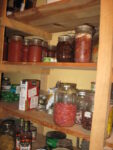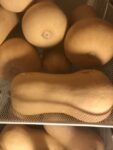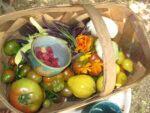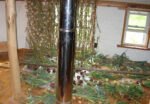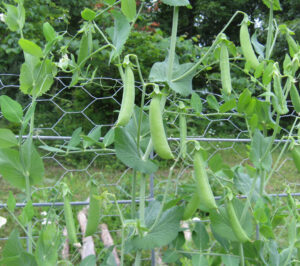A version of this column first ran in the Roane County (WV) Reporter and Times Record. Support local journalism! Subscribe to your local newspaper. This is one of a series of blogs for new gardeners. Start reading the whole series here: Part 1.
Because of the virus, there was a big upsurge in gardening this spring, and as a result, many seed companies ran low and there were long delays on seed orders. There was also a shortage this summer of canning lids. Since the virus is still with us, and other scary things loom on the horizon, we may well see similar situations next year. Therefore, if you want to garden next year, you’d be wise to put your order in early; don’t wait until spring. And if you have a garden this year, try to save at least some seeds yourself to plant next year.
Doing this right includes many complications, so several whole books have been devoted to the subject. But even if you don’t have the information or for other reasons can’t “do it right,” saving what seed you can could mean you can plant a crop you care about next year, so it’s worth doing. The main issues in doing it right are: the need to save seed from an adequate number of different plants to have good genetic variability; avoiding having your chosen plants cross with other varieties or other closely related species, including weeds; and collecting mature seed, and then drying it adequately for storage.
Another consideration is that if your original seed was hybrid, the seed you save won’t come true to type. It’s better to save seed from “open pollinated” that is, non-hybrid seed (hybrids are sometimes labeled F1). But if all you have is hybrids, you can save seed, just be prepared for the offspring to vary widely.
The number of different plants from which you should save seed varies by species. At one extreme is corn, an “obligate outcrosser” from which you should ideally collect some kernels from 100 different plants. At the other is squash from which it’s fine to get all your seed from one fruit. Six is a number I’ve seen for many crops. Of course, for some crops you can use the plant and save some seed at the same time—corn, fortunately, is in this category (but not sweet corn, which is harvested long before the seed is viable). For some plants, seed is ready well past the point where you’d harvest the fruit for eating.
Some plants don’t even flower until the second year, and while a few (like kale, swiss chard, beets and carrots) may survive the winter and flower in spring, others have to be coddled through the winter to bloom the next year.
Peas and beans are good to save because they don’t cross with anything wild—you just let some plants go on until the pods are dry, then dry more indoors before storing (in a wet year, you may have mold problems. Consider harvesting a bit earlier to avoid a long wet spell).Most common beans will cross with each other; this includes snap beans, pole beans and dry beans. Asparagus beans and cowpeas (black-eyed peas) are a different species and only need to be isolated from each other. Limas, favas, peanuts and soybeans are each different species and won’t cross. But you may be able to save seed from more than one common bean by timing the blooming to not overlap, or by separating the different varieties by 30 feet.
Tomatoes and peppers don’t cross much at all, and can just be let to fully mature (the peppers should be red); some say you should then ferment the tomato seed in water for a couple of days before drying it thoroughly.
Squash are easy, but they do cross. You can prevent this by taping the female blossoms shut before they open (the females are the ones that have the baby squash behind the flower), then brushing the male flowers against them and retaping. There are four common species; most summer squash with cross with pumpkins but not with butternuts. Cushaws are a different species and won’t cross with anything else. Cucumbers and melons will not cross with squash or each other, so you can freely save seeds from all of these. You can also collect good seed from fruits you eat, but cucumbers and summer squash must be let go beyond the desirable harvesting stage if you want to save seed.
Lettuce will often take care of the seeding all by itself if you just don’t pull the bolted plants. Then you may see volunteers coming up nearby in the fall or the spring. Same with radishes. Spinach is more complicated as it has more than two sexes (avert your gaze) and you specifically want the last plants to bolt, since early bolting is the chief undesirable characteristic in spinach.
There are a few crops for which we don’t mess with seeds. Potatoes are started from chunks of last year’s potatoes, and you can use your own if you have a cold, moist (but above freezing) place to overwinter them. It may be better to buy certified seed sets if they’re available, to avoid disease. But if they’re not available next spring and you still have some of this year’s potatoes, by all means cut and plant them!
Sweet potatoes are also propagated vegetatively, but they are stored in a cool, dry place like a pantry shelf, and the slips started in water (I discussed this last spring). Rhubarb and asparagus are perennials, usually started from cuttings rather than seed.
Some seeds may need to be planted the following year; other kinds last up to six years in cool, dry, dark storage. Fully dry seeds may be frozen to last indefinitely. Don’t forget to label your seed, with the year as well as the variety.
Read the rest: Part 1. Part 2. Part 3. Part 4. Part 5. Part 6. Part 7. Part 8. Part 9. Part 10. Part 11. Part 12. Part 13. Part 14. Part 15. Part 16. Part 17. Part 18. Part 19. Part 20. Part 21.
